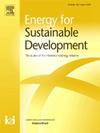巴基斯坦城乡家庭能源平衡表的编制:能源转型的影响
IF 4.9
2区 工程技术
Q2 ENERGY & FUELS
引用次数: 0
摘要
本研究旨在分析巴基斯坦农村和城市家庭的能源消费模式和向清洁能源的过渡。采用自下而上的方法,本研究开发了2020年农村和城市家庭按能源和服务类型分类的详细住宅终端用户能源平衡表(EBT)。这种方法对于理解数据受限环境下的最终用途住宅能源消费模式以及温室气体和空气污染物的排放清单是有价值的。我们评估了家庭人均能源消耗(PEC)及其与GDP、家庭规模和城市化等社会经济特征的关系。利用详细的EBT,分析了温室气体和大气污染物的排放清单。我们揭示了城乡地区能源消费的不平等和差异。农村地区的人均收入是城市地区的1.38倍。城市地区的电力、天然气和液化石油气(LPG)的PEC较高。在农村地区,木柴和生物质燃料的数量和比例更高,烹饪占总能源消耗的87%。我们发现人均收入和城市化是能源需求和转型的主要参数。城市地区的人均温室气体排放量是城市地区的2.29倍,而黑碳和二氧化硫等空气污染物在农村地区分别是城市地区的3.61倍和1.4倍。这意味着,通过能源转换,室内空气污染物可以减少;然而,为了大幅减少温室气体排放,电力部门的脱碳是必要的。本文章由计算机程序翻译,如有差异,请以英文原文为准。
Development of the energy balance table for rural and urban households in Pakistan: The implications of energy transition
This study aims to analyze energy consumption patterns and the transition to clean energy in rural and urban households in Pakistan. Using a bottom-up approach, this study develops a detailed residential end-use energy balance table (EBT) disaggregated by energy source and service type for 2020 for rural and urban households. This approach is valuable for understanding end-use residential energy consumption patterns and the emission inventory of GHG and air pollutants under a data-constrained environment. We assess household per capita energy consumption (PEC) and its relationship with socioeconomic characteristics such as GDP, household size, and urbanization. Using the detailed EBT, the emission inventory of greenhouse gases (GHGs) and air pollutants is analyzed. We reveal inequality and disparity in energy consumption between rural and urban areas. The PEC in rural areas is 1.38 times higher than in urban areas. PEC of electricity, natural gas, and liquefied petroleum gas (LPG) in urban areas is higher. In rural areas, the quantity and share of firewood and biomass fuels are higher, and cooking is 87 % of total energy consumption. We find that per capita income and urbanization are major parameters for energy demand and transition. The per capita GHG emissions are 2.29 times higher in urban areas, but air pollutants such as Black carbon and Sulphur dioxide are 3.61 and 1.4 times higher in rural areas, respectively. This implies that by energy transition, indoor air pollutants could be reduced; however, decarbonization in the power sector is required for a drastic reduction in GHG emissions.
求助全文
通过发布文献求助,成功后即可免费获取论文全文。
去求助
来源期刊

Energy for Sustainable Development
ENERGY & FUELS-ENERGY & FUELS
CiteScore
8.10
自引率
9.10%
发文量
187
审稿时长
6-12 weeks
期刊介绍:
Published on behalf of the International Energy Initiative, Energy for Sustainable Development is the journal for decision makers, managers, consultants, policy makers, planners and researchers in both government and non-government organizations. It publishes original research and reviews about energy in developing countries, sustainable development, energy resources, technologies, policies and interactions.
 求助内容:
求助内容: 应助结果提醒方式:
应助结果提醒方式:


